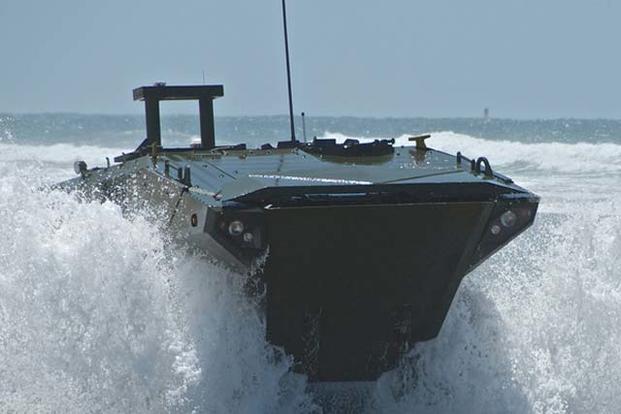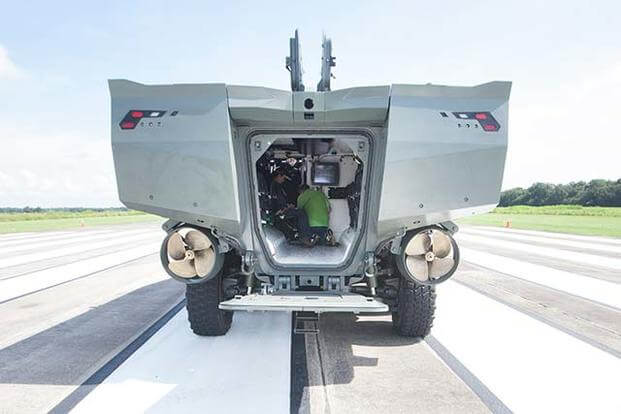QUANTICO, Virginia -- Extra legroom or 360-degree cameras? Central air conditioning, or boosted horsepower?
At the Modern Day Marine expo here this week, Marines had a chance to kick the tires and test the seats of two competing versions of the Corps' future amphibious combat vehicle, the faster and more survivable successor to the aging assault amphibious vehicle.
For the first time, one company, the British defense firm BAE Systems, brought a production model to the show, one of 16 that will be delivered to the Marine Corps next year for testing. The other, Virginia-based SAIC, brought a pre-production model based on the Terrex infantry carrier already in use with the Singapore armed forces.
In an age when programs like the F-35 Joint Strike Fighter and the Ford-class supercarrier have blown past budget estimates and production deadlines in development, the ACV 1.1 is a rare thing: an acquisition good-news story.
Marine officials said both companies were expected to deliver the first batches of vehicles to the Marine Corps a month early, earning an incentive bonus in the process.
"It's really a wonderful example of some of the things that people talk about, how you make decisions right, prototyping, tailoring the pros to get the program fast-tracked, and more importantly, get the requirements right," Col. Andrew Bianca, deputy for Program Executive Officer of Land Systems told Military.com.
Related Video:
Modern Day Marine: SAIC ACV 1
The Corps had several costly false starts before arriving at this amphibious vehicle sweet spot.
The first planned successor to the AAV, the Expeditionary Fighting Vehicle, was cancelled by then-Defense Secretary Robert Gates in 2011 due to affordability concerns after the Corps had already dumped $3 billion into the program.
Next, the service worked with firms to develop the Marine Personnel Carrier as a complement to a future amphibious vehicle, but that program too was cut short amid budgetary belt tightening. The service also struggled to define requirements for the ACV, challenged by a desire for fast water speed that did not appear attainable.
Ultimately, the Marines in 2014 laid out a phased approach: they would develop and buy a Phase 1 ACV with modest water speed and a faster-swimming Phase 2 vehicle as the technology became available.
Aside from survivability and land speed, both ACV 1.1 models are different from the legacy AAV in one key way: They move on eight wheels, instead of on tracks. For Marines who spent a career on amphibious vehicles (the slogan YAT-YAS, or 'you ain't tracks, you ain't s*** is popular with this community), this is nothing short of revolutionary.
"The world we came from, the way you get mobility is by putting tracks on a vehicle," Bianca said. "Frankly, ten years ago, I would never have believed you, as a tanker, that is goes as many places and over the kind of terrain it does."
Specs
Both SAIC and BAE have partnered with international corporations to produce their vehicles.
BAE is collaborating with Italian company Iveco, a subsidiary of the automobile maker Fiat Industrial, to build its ACV 1.1. SAIC is teaming up with Singapore Technologies Kinetics to build its offering, which it's calling the Terrex 2. Both vehicles can swim at six knots, or just under 7 miles per hour. The BAE model can travel on land up to 70 miles per hour, while the SAIC version can go 55.
John Swift, the program manager for BAE Systems, said the company had opted to upgrade the vehicle's engine from 500 horsepower to 690 horsepower in anticipation of incremental future requirements. The model has Iveco's trademark H-drive structure, eliminating axles and giving the vehicle more maneuverability. It seats 13 Marines plus three crew members with ample legroom, and has a system that allows seawater to cool the engine as it swims, meaning time in the water is limited only by fuel.
"If you give me 100 more gallons, give me a set of radios and ammunition, and we can go ahead and invade Maryland this afternoon," Swift said. "This vehicle has everything on it."
SAIC's ACV 1.1 pre-production model is more snug than its competitor's, with room for just 11 Marines in addition to crew members and a confined space that requires passengers to use the opposite foot rest. But keeping troops' feet off the floor is a safety feature that would allow them to survive a blast from directly below the vehicle relatively unscathed, program executives said.
The vehicle is also more technologically flashy, with an internal screen that projects 360-degree images from cameras on every side of the vehicle. A gunner can remotely operate a mounted .50-caliber machine gun from within the vehicle using a joystick and the cameras. The vehicle also has an integrated overhead air conditioning system to cool the Marines in close quarters.
"We think Marines are going to take to this drive by camera concept very quickly," said Anthony Herlihy, director of Marine Corps business development relations for SAIC. "Over 400 of these systems are in service with the Singapore Armed Forces right now."
Marines Meet ACV
After the two companies deliver 16 vehicles apiece to the Marine Corps in four-vehicle installments, the service will continue developmental testing, bringing in fleet Marines from amphibious vehicle specialties to train on the systems, said Col. Wendell Leimbach Jr., deputy program manager for the Marine Corps advanced amphibious assault program office.
"We'll be pulling in those young Marines and asking their feedback and making sure the requirements that we have set and are represented by these prototypes are going to meet their needs on the battlefield," he said. "We are already pulling in Marines now that are getting trained to be the crewmen for these vehicles, and those Marines will then be the individuals that use the vehicles through the developmental test phase."
The Pentagon's director of operational test & evaluation, he said, will also test the vehicles, putting active-duty Marines through operational scenarios and collecting feedback on how the vehicles perform and whether they met the needs of the troops operating them. Current plans call for this testing phase to last one year, with a downselect to one vehicle maker in 2018.
Just to have the models on display for Marines this week was an important step, Leimbach said.
"It's absolutely critical," he said. "We get to live and see these programs on a day to day basis, but these vehicles are actually being built for the Marine Corps and specifically to carry Marine infantry around the battlefield. They are the ultimate customer of what there vendors will be producing for us, and it's important that the young Marines get an opportunity to come and see and feel and sit in the vehicles so that they know there is next-generation technology coming down the road."
-- Hope Hodge Seck can be reached at hope.seck@military.com. Follow her on Twitter at @HopeSeck.































